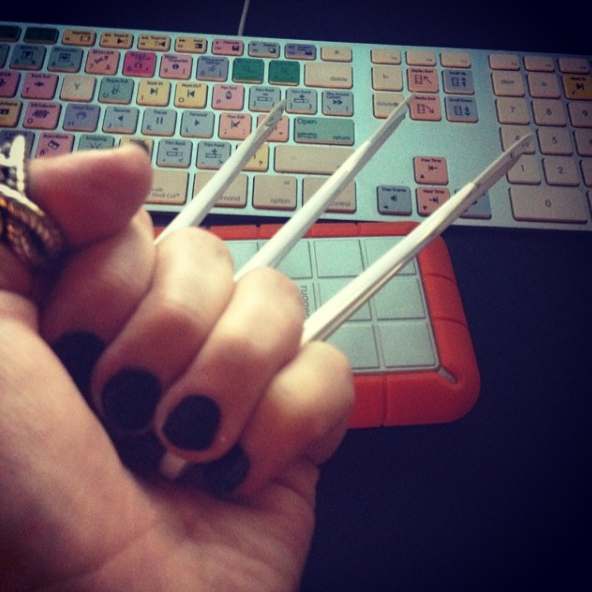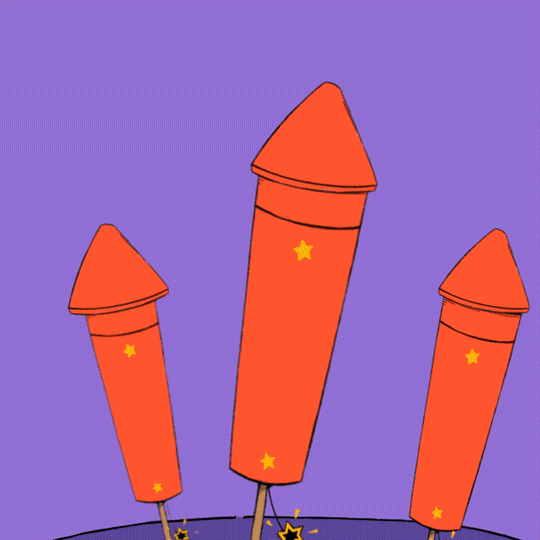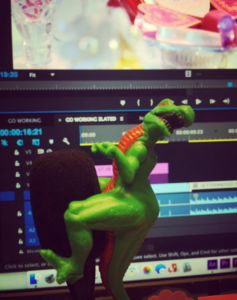In a post production filled world teeming with editors working on TV, film, sports, live shows and even the news, there are many in-house editors working on a huge range of less visible work. From commercial spots to web pre-rolls or even internal pitch reels, there is a rapidly expanding role of “staff editor” in markets all across America.
Currently, I’m one of those editors working at an advertising agency. Before landing the job, I didn’t even realize this was an option for me. Yes! These kind of jobs in our industry exist and are good for experience. Like most people in editorial, I aspire to be editing television and film one day. Because of this, there is a tendency for those in our industry to look down upon editing roles outside of New York or Los Angeles, or even post jobs that aren’t on narrative work.
The truth is that it’s not typical for a great majority of aspiring editors to magically start out cutting those kinds of projects. Feature film jobs with a budget are shrinking – and it’s a very long road to get to cut those – so if your vision is only set to movies, you might be in for some disappointment. But fear not, thanks to the democratization of tools and the internet, there’s a lot more creative work out there than you might have been aware! Commercial work has always been big, but now digital television, web series and social videos are becoming broader, more credible and more requested than ever.
The great thing about cutting this work? I’m exposed to a lot of different techniques and tools, and I’ve had to learn how to interpret technology and people at the same time. Plus, as a staff editor, I have a place to go every single day. If I’m not currently in high demand, I’m utilizing my resources to hone other skills.

let’s do this, bub!
It’s a little difficult to discuss what I do. It’s not a feature film. It’s not some epic TV series. Sometimes, it doesn’t get released or I just can’t talk about the specifics. Working in a place where we’re often pitching many ideas that need polished visuals, I do plenty of work that is passed on that consequentially never sees the light of day, stowed away on a hard drive or dusty corner of a password protected hosting site. One of the hardest parts of this in-house role is working every bit as hard on internal projects to help them get to the next stage of production, knowing they’re more than likely to die on the vine through sheer volume.
However, with every project (internal or not), I grow in skills and succeed through new creative and budget challenges. I learn from mistakes made in the past and find better ways to approach problems going forward. It doesn’t matter if the project is viewed widely. I have still gleaned new experiences from my efforts.
Working specifically inside an agency is a special kind of “crazed” environment that we tackle on an every day basis. We’re navigating many deadlines throughout the week, managing a lot of input and directions, and adding our own touches– all the while keeping on the client’s deadline. I do a lot in a small frame of time, which may be different than the flow of long form editing. My work is a very bursty type of chaos, just like the nature of advertising is very feast-or-famine. Decisions are made quickly, and I can suddenly be thrust into a new project that needs to be finished yesterday.

Made this GIF for NC Education Lottery social sharing. Dripping with shiny!
So, what do I do on a daily basis?
It can certainly vary from agency to agency, but I do everything from developing concept pieces up to editing final spots. Essentially, I’m often working on clay that hasn’t taken shape and only has a few pieces formed. Sometimes the pieces are more formed, laid out in very detailed instructions or decisions. I never know what I’ll get, and it’s up to me and the creatives and account executives get the rest together. Creatives include designers, writers, or directors. They’ll write scripts, find or design some of the graphic assets, and assist in direction of the spot. Account executives manage the brand needs because they know the brand inside and out!
On the tech side of things, I’m most often inside Adobe Premiere Pro and After Effects. I also use Photoshop and Illustrator, InDesign, Audition, and a few other tools or plugins. I edit on a Mac, but easily could use a PC – I really don’t care what I’m using. The tools are just that. It’s you that brings the skills, and that’s the only thing that matters. NLE wars are less important for in-house staff, and for editors outside the usual major markets – a very nice change of pace.
I frequently trouble shoot my own issues with the computer or programs. In fact, I LIKE doing it. It saves me time and hassle when it happens again, and I’ve learned a lot about what happens under the hood. I don’t often have time to wait for IT or someone else to fix it. Recently, the IT dept. serious but tongue-in-cheek asked me if I’d like to join them because of my track record of solving issues. If I do get assistance, I want to know why it worked and how to do it myself. I utilize that motivation towards each project – rely on yourself first! I’ve solved everything from AJA playback delays to faulty cords and everything in-between, plus figuring out future issues because of it.
In any given month, my hands are on several different projects. One day I might be pulling tons of inspiration videos or stock assets to cut an internal concept piece for creative to show clients. I may not always be working with the “prettiest” of shots in this stage, so I have to see beyond what is in front and envision what it could be. Imagination is essential.

Kitten. Fireworks. Made this GIF in AE for NCEL.
Other times, I dive into After Effects to work on plenty of motion graphics and animations of many kinds. How I’ll approach each project is closely tied to the needs of the client. For brands looking to get more social, I end up making animations for GIFS to share around — hey, I’m not complaining.. I love gifs!
Often times, I’m cutting together storyboards with a bit of animation to help get an idea across because having a visual pieced together makes decisions about keeping it or trashing it much easier. In this role, I confidently feel my After Effects skills have stayed honed and increased quite a bit. I use it so often and continually try to challenge myself to figure out something new or shortcuts to save time, which is something any in-house editor should strive to do.
And let us not forget the audio work. I create lots of “scratch” voice-over recordings to form how the tone and delivery should be. Mixing voice-over and music on lots of various videos is another big part of my job. If audio levels aren’t correct, it can be hugely distracting and seriously damage the pitch of a concept!
For big brand shoots, sometimes I even serve as an assistant editor, organizing, grouping and creating deliverables for other editors — when I’m not editing them myself. Not relegated to internal-use-only, I’m also cutting commercial spots that later play on TV. Different brands and clients mean many different possibilities for delivery: the web, TV, ad pre-rolls, or a revised spot to play in cinema before a movie. There are a lot of possibilities!
Between ALL that, I’m also managing ‘work orders’ put in for compressions, re-edits, social media needs, and much more that have their own deadlines, as well. Even in one given day, I’ve got several things that could be due spread out in the day, and I may not have known about any of them when I came into work that day. I have to manage time with an adamantium grip.
How does the pitch process work?
First, there are bids and a whole host of mysterious but effective paperwork happens. We make it in a group of “possibles” being considered along with other agencies. Budgets are formed. Ideas are taking shape with the creative, and desired needs or ‘must haves’ in the spot come in from the account executives. This funnels over to producers, who figure out the timelines and schedules, budgets, editors, voice-over sessions, and more. Then the brand spot makes its way to me to edit it all together.
In these type of internal videos, anything goes – we’re selling a concept that will be created in its final form later. It still has to be something that can actually be accomplished should it go through. This involves quite a process and a challenge, and many a revision to get to a balanced place.
Editors and creatives work very closely together and creatives and account execs work closely together. Creatives see my work first after getting a rough cut together. Revisions happen, and they may happen some more. And that, a head creative views it. Then account execs come into the picture to offer opinions. Sometimes they both come together in my edit room when it comes time to reviewing things right before the client. Then a client reviews the work and offers their opinion on things. Then it all loops back around again and again until the deadline.
This process is important and not unlike the same kinds of revision processes you’d find in film or television editorial During revisions, creatives might hang out on the couch behind me in my room while I cut to do live edits because some people work better that way. If there are any issues, I’ll offer my thoughts on what’s working and what’s not. I have to constantly know the point of the brand for the edit, so I do my own research or ask them about it to quickly understand – that way I have an informed opinion when asked. And sometimes account clashes with creatives! Or the client wants something the creative isn’t keen on. There’s a large balancing act to perform when this happens, ensuring the video is its very best using the collective information and revisions that come back my way. It’s no easy feat, but it’s a necessity to be the calm center.
And maybe the most important skill learned at a job like this? People and politics.
Often times, someone will ask for things I don’t have. They may have wonky or contradictory specs. They’ll want incredibly complicated, colorful layers brought down into a super tiny sized GIF (and still look good?) or a lengthy HD video crunched so small it’s pixels. Or my collaborators may not have any idea about anything direction-wise, except here’s this footage and what can we do with it? In doing that, I have exercised creative skills crafting the story and the focal point for the brand, all without even a script. I’ve learned how to say no. I’ve gained confidence in my gut. I’ve learned a hell of a lot in the process – how to set, manage and exceed expectations. Sometimes all in the same day.
I’m touching many tools and many projects all at once, challenged to learn new things every day that fit into the constraints of different expectations or budgets. It may not be the traditionally sexy work that every young editor aspires to, but it has served me well. And working in this role has inspired me to talk about my work much more. There’s so much more to post production beyond what you can find on Netflix. What about that YouTube pre-roll ad that reminded you that show was even ON Netflix?
This sort of editing job is arguably more accessible than more visible roles in large cities, and provides essential industry experience, from tech to soft skills, for anyone in post production. Traditional film and television is mostly available in New York or Los Angeles — if you don’t live there, the struggle is real.
Whether you aspire to move on to narrative television or documentary features or you’re going to continue to climb the ranks that corporate video has to offer, your work is valid and important. Being invisible can make it feel like the work you’re doing isn’t on par with Hollywood when in reality, it’s all the same skills and then some! The growth of “other” kinds of media creation like digital TV and web series is bringing a whole bunch of new jobs to our industry industry, and that’s important for the future of post production. So make yourself known – talk about your work online and in person and be proud of what you’re accomplishing, no matter what it is!





